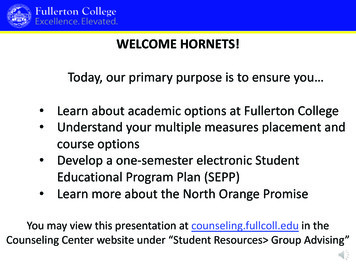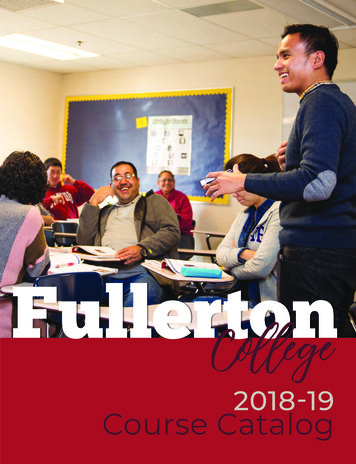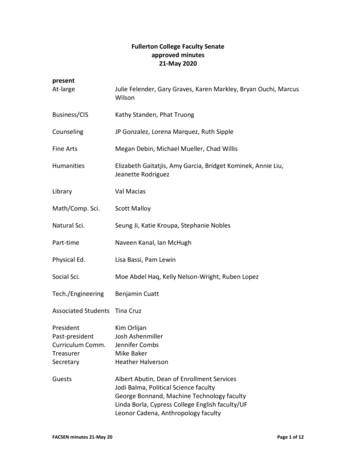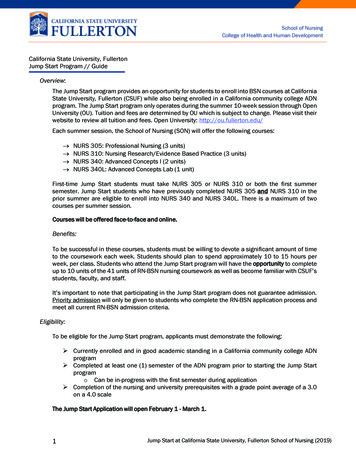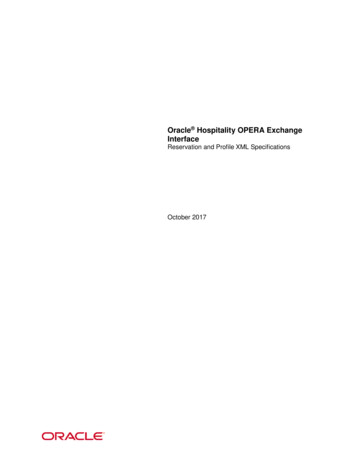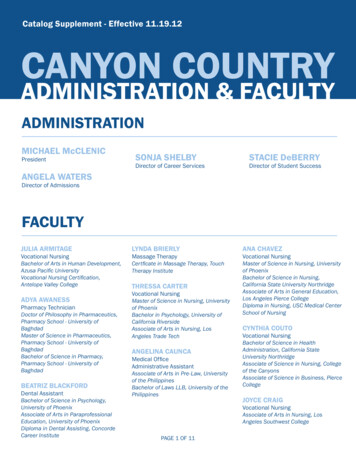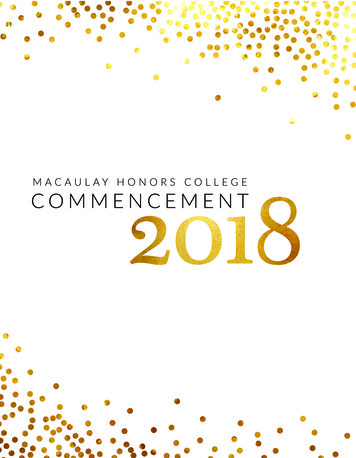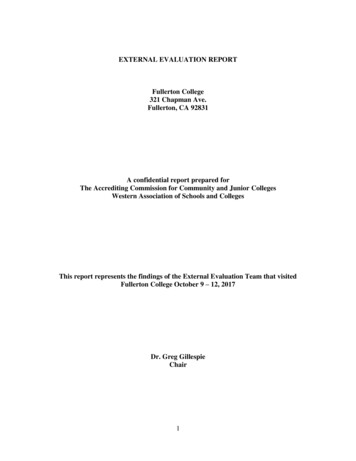
Transcription
EXTERNAL EVALUATION REPORTFullerton College321 Chapman Ave.Fullerton, CA 92831A confidential report prepared forThe Accrediting Commission for Community and Junior CollegesWestern Association of Schools and CollegesThis report represents the findings of the External Evaluation Team that visitedFullerton College October 9 – 12, 2017Dr. Greg GillespieChair1
2
List of Team MembersDr. Greg Gillespie (Chair)ChancellorVentura County Community CollegeDistrictMr. David MartinChief Financial OfficerCity College of San FranciscoMs. Jeannine StokesInterim Assoc. Dean of Human ResourcesMt. San Jacinto CollegeDr. Kim Hoffmans (Assistant)Vice President, Academic Affairs/ALOVentura CollegeMs. Denise WhisenhuntVice President of Student ServiceSan Diego City CollegeMr. John RichardsDean of Career and Technical EducationKapiolani Community CollegeMr. William TuriniPolitical Science InstructorReedley CollegeDr. Katrina VanderWoudeVice President Academic AffairsGrossmont CollegeMr. Christopher HowertonProfessor of Communication Studies/SLOCoordinator/Senate VPWoodland Community CollegeDr. Richard SantosInstructor, Linguistics/ESLFresno City CollegeMs. Aulii SilvaFaculty, Professor-Counselor andCoordinator Native Hawaiian StudentSupportLeeward Community CollegeDr. Lisa Cooper WilkinsVice President of Student ServicesSan Joaquin Delta CollegeDr. Kristi BlackburnDean of Institutional Effectiveness,Research, and PlanningCerritos College3
Summary of the External Evaluation ReportINSTITUTION:Fullerton CollegeDATES OF VISIT:October 9 -12, 2017TEAM CHAIR:Dr. Greg GillespieA thirteen member accreditation team visited Fullerton College October 9-12, 2017 for thepurpose of determining whether the college continues to meet Accreditation Standards,Eligibility Requirements, Commission Policies, and United States Department of Education(USDE) regulations. The team evaluated how well the college is achieving its stated purposes,providing recommendations for quality assurance and institutional improvement, and submittingrecommendations to the Accrediting Commission for Community and Junior Colleges (ACCJC)regarding the accredited status of the college.In preparation for the visit, the team chair attended a team chair training workshop on August 3,2017 and, together with the team assistant, conducted a pre-visit to the campus on September 19,2017. During the visit, the chair and assistant met with campus leadership and key personnelinvolved in the self-evaluation preparation process. The entire external evaluation team receivedtraining provided by staff from ACCJC on September 7, 2017.The evaluation team received the college’s self-evaluation document and related evidenceseveral weeks prior to the visit. Team members found it to be a comprehensive documentdetailing the processes used by the college to address Eligibility Requirements, CommissionPolicies, and Commission Standards. The team confirmed that the self-evaluation report wascompiled through broad participation by the entire college community, including faculty, staff,students, and administration. The team found that the college provided a self-evaluationaddressing all of the standards and two quality focus essays related to improvement (1) distanceeducation and (2) institutional effectiveness.The visiting team began its work at Fullerton College on Monday, October 9 starting with anintroduction to the president’s Executive Staff including: President Schulz, Director McPheronof Campus Communications, Director Ayon of Institutional Research and Planning, VicePresident José Ramόn Nuñez of Instruction, Vice President Gilbert Contreras of StudentServices, and Vice President Rodrigo Garcia of Administrative Services. Next, the team touredthe beautiful campus with the assistance of two Fullerton College students. The remainder of theday consisted of several meetings with multiple groups (Accreditation Steering Committee,Program Review Committee, Classified Senate, Faculty Senate, Student Learning Outcomes andAssessment Committee, and Staff Development Committee).On day two of the college visit, the team met with the following groups: Curriculum Committee,Student Services Management Team, Planning & Budget Steering Committee, Library Team,Dean’s Council, Counseling Team, Distance Education Advisory Committee, InstitutionalIntegrity Committee, and Associated Students. Small group meetings were also held withPresident Schulz and Vice President Nuñez. Team members attended various unique events on4
campus such as: Suicide Prevention presentation, Associated Students’ Club Rush, Food Pantry,and an Art Gallery Event. To close the day, most of the team attended a campus-wide forum(over 60 in the audience) and a few members of the team went to the District office for meetingswith Chancellor Marshall, Board members, and to attend a board meeting.On the third day, the team was involved in additional meetings with the Director of InstitutionalResearch & Planning, Vice President of Instruction, Vice President of Student Services, FacultySenate President, Career Technical Education Representatives, Title IX Representatives, Directorof Communications, and the President’s Advisory Council.In addition to the above assemblies, the team reviewed 30 online classes, observed 5 classes oncampus, and spoke individually with over 30 students. On the final day of the visit, Team ChairGillespie met with Fullerton College President Schulz prior to the closing meeting with thecollege community to communicate the team’s report of commendations and recommendations.Overall, the team met with multiple students and employees; as well as reviewed numerousmaterials supporting the self-evaluation report in the team room and electronically, whichincluded documents and evidence supporting how well the college met the Standards, EligibilityRequirements, Commission Policies, and USDE regulations. Evidence reviewed by the teamincluded, but was not limited to, documents such as institutional plans, program reviewprocedures and reports, student learning outcomes evidence, distance education classes, collegepolicies and procedures, enrollment information, committee minutes and materials, and collegegovernance structure. The team viewed evidence and documentation through the college’sintranet and by means of electronic copies provided on flash drives.5
Fullerton CollegeMajor Findings and RecommendationsCollege CommendationsCollege Commendation 1: The college is commended for the Library, Learning Resources,and Instructional Support Programs and Services Division (LLRISPS), specifically theirAcademic Support Center programs, which demonstrate robust and innovative partnershipsthroughout the college coupled with best practices to support student access and success.(Standard II.B.1)College Commendation 2: The college is commended for the intentional creation of flexiblelearning spaces that are not only beautiful and comfortable, but that also provide access tomuch needed resources such as technology and the assistance of professional and peer staff.The expanded offerings in the Library Reserves area are noteworthy; particularly the robustpartnership with the EOPS program and all the materials available for use to studentparticipants in that program as well as the wide variety of offerings in the circulation arearanging from laptop and calculator checkouts to phone chargers all of which positivelyimpact the student experience at the college. (Standards III.B.1; III.C.3)College Commendation 3: The college is commended on the innovative development andimplementation of the Cadena Cultural and Transfer Center, a fusion of both transfer andequity minded practices that promote completion and transfer of Fullerton College students.(Standard II.C.3)College Commendation 4: The college is commended for their Student Services Division’shigh-touch and high tech approach by leveraging technology to enhance in-person and virtualservice delivery. Examples include Zoom Videoconferencing pilot, use of a mobile robot toprovide remote access to the classroom, use of kiosks and the use of other tools to reducelines and speed up processing. (Standard II.B.1; II.C.3)College Commendation 5: The college is commended for their culture of trust, collegiality,communication, effective working relationships, and a committed focus on “radical studentcenteredness.” Everyone is supporting the engagement and success of the students. Thepride that students and employees share about Fullerton College is exemplified by their“Once a Hornet, Always a Hornet” motto. (Standard IV.A.1)College Commendation 6: The college is commended for their high quality facilities,grounds, and historical preservation. The college community expresses understandable pridein the campus. The facilities and accompanying landscape have created an invitingatmosphere while being attentive to functionality and efficiency. The college buildings andgrounds are well maintained, safe, and well equipped which contributes to a positive andenjoyable learning and teaching environment for students and employees. (Standard III.B.1)College Commendation 7: The college is commended for providing frequentcommunication regarding campus initiatives, activities, and events through effective use of6
the website and social media, the president’s weekly newsletter, the Fullerton College NewsCenter, press releases, and print publications. These efforts have created strong internal andexternal community engagement for Fullerton College. (Standard IV.B.6)College RecommendationsCollege Recommendation 1 (Compliance): In order to meet the standard, the teamrecommends that the college assess Institutional Student Learning Outcomes (ISLOs) andengage in sustained substantive and collegial dialog of outcomes in pursuit of continuousquality improvement of courses and programs. (Standards I.B.1; II.A.2; II.A.3)College Recommendation 2 (Compliance): In order to meet the standard, the teamrecommends that the college develop methods to ensure and evaluate that faculty teachingdistance education meet generally accepted academic and professional standards andexpectations for distance education instruction related to (1) regular and effective contactbetween instructors and students and (2) professional development. (Standards II.A.2,II.A.7).College Recommendation 3 (Improvement): In order to increase effectiveness, the teamrecommends that the college broadly communicates the institution-set standards and theresults of its assessment and evaluation activities so that the college uses the information toset appropriate priorities at department and institutional levels. (Standards I.B.3; I.B.8)College Recommendation 4 (Improvement): In order to increase effectiveness, the teamrecommends that processes identified in the Integrated Planning Manual are systematicallyassessed to determine the effectiveness of committees and the results are used for continuousquality improvement. The access to committee minutes, current committee membership, andcommittee goals and accomplishments will support effective communication. (StandardsI.B.1, I.B.3, I.B.7).College Recommendation 5 (Improvement): In order to increase effectiveness, the teamrecommends that the student support areas use disaggregated assessment data to continuouslyimprove student support programs and services. (Standard II.C.2).7
District CommendationsDistrict Commendation 1: The team commends the District for ensuring technologyinfrastructure and capacity, through hiring and succession planning in advance of retirementsas part of District Information Services. The time it takes to train new programmers willallow for knowledge transfer, ensuring long term sustainability for District InformationServices support. (Standard III.C.2)District Commendation 2: The team commends the District for the creation and recentimplementation of an integrated Leadership Academy that provides innovative training forall constituent groups. (Standard III.A.14)District Commendation 3: The team commends the District for creating human resourceprocesses that create inclusive hiring practices for all employee positions. The District is tobe commended for its strong focus on diversity and equity aligning hiring with itsinstitutional mission and goals. (Standard III.A.1)District RecommendationsDistrict Recommendation 1 (Improvement)In order to increase effectiveness, the District should fully implement its new plan to reviewall chapters of the Board policies and associated administrative procedures over a 6-yearcycle. (Standard IV.C.7).District Recommendation 2 (Improvement)In order to increase effectiveness, the governing board should review both its BP 2740 andAP 2740 to create a clear direction for the ongoing training program for board development.Both policy and administrative procedures should reflect that all Board members engage inongoing training program for board development, including new member orientation.(Standard IV.C.9).District Recommendation 3 (Improvement)To increase effectiveness, the team recommends that the Colleges and NOCCCD review thecurrent budget model to ensure financial resources are sufficient to address productivityfactors, FTES targets, and the impact in the model of adjunct, overload and re-assign timeneeded to support and sustain student learning programs and services. (Standard III.D.1,III.D.4).8
IntroductionFullerton College is one of the oldest community colleges in California and it began operating in1913 as part of Fullerton Union High School. The college moved to a 14 acre site adjacent to thehigh school in 1935 and the campus has expanded to now include 83 acres with 47 buildings, aparking structure, a Lab School (childcare center), and a horticulture building. The college ispart of the North Orange County Community College District governed by a seven membertrustee board which has responsibility for Fullerton College, Cypress College and the School ofContinuing Education.Student enrollment at the college increased 24% from Fall 2011 to Fall 2016. Unduplicatedenrollments at the college have remained around 25,000 students since Fall 2013. The collegeserves a diverse student body. Over 55% of the students are of Hispanic/Latino origin which isan increase of 11% since 2011. Over the past few years, the college has experienced an increasein the number of students who are first generation and from low socioeconomic backgrounds.To support Fullerton College students, programs have been put in place, such as the TransferAchievement Program, Puente Project, Umoja, INCITE, Entering Scholars Programs and others.Fullerton College offers 93 Associate degrees and 147 vocational certificates to prepare studentsfor transfer and careers across a broad range of disciplines and employment sectors.Since Fullerton College’s 2011 ACCJC site visit, the executive administration is new withPresident Schulz beginning his leadership in 2016. Vice President of Instruction José RamόnNuñez is the longest serving vice president beginning in 2014 with Vice President GilbertContreras of Student Services in 2016 and Vice President Rodrigo Garcia of AdministrativeServices in 2017. With over 1,244 faculty and staff, the college has experienced an increase of28% of employees since their 2011 ACCJC site visit (22 administrators, 348 full-time faculty,582 adjunct faculty, and 292 classified staff).Fullerton College’s accreditation was last reaffirmed in 2011.9
Eligibility Requirements1. AuthorityThe Accrediting Commission for Community and Junior Colleges (ACCJC) is a regionalaccrediting body recognized by the U.S. Department of Education and granted authoritythrough the Higher Education Opportunity Act of 2008. Fullerton College has been fullyaccredited by the ACCJC of the Western Association of Schools and Colleges (WASC)since 1952. The evaluation team confirmed that Fullerton College is authorized tooperate as a post-secondary degree-granting institution.The college meets the ER.2. Operational StatusThe evaluation team confirmed that Fullerton College is operational and provides a rangeof educational programs to approximately 25,000 students each of the last four fallsemesters. The college enrolled 24,984 students during Fall 2016 with 35% of thosestudents enrolled full-time (12 or more units).The college meets the ER.3. DegreesThe evaluation team confirmed that the college offers Associates of Arts and Associatesof Science degrees with the majority of courses offered leading to a degree and/ortransfer. More than 70% of enrolled students over the past four years have indicated theintent upon applying to obtain a degree or transfer.The college meets the ER.4. Chief Executive OfficerThe current Fullerton College president served as interim president from July 2015 toApril 2016 and was appointed president of the college by the Board effective April 2016.The evaluation team confirmed that the North Orange County Community CollegeDistrict (NOCCCD) Board employs a president as the Chief Executive Officer (CEO) ofFullerton College. The CEO of the college reports to the Chancellor. The evaluationteam confirmed that the CEO has the authority to administer Board policies at thecollege.The college meets the ER.5. Financial AccountabilityThe evaluation team confirms that Fullerton College annually engages an independentand qualified audit firm to conduct audits of all financial records. Audits are certified andall explanations or findings are documented appropriately. Audit reports are available tothe public.The college meets the ER.10
Checklist for Evaluating Compliance with Federal Regulations and RelatedCommission PoliciesPublic Notification of an Evaluation Team Visit and Third Party CommentEvaluation Items:X The institution has made an appropriate and timely effort to solicit third party comment inadvance of a comprehensive evaluation visit.X The institution cooperates with the evaluation team in any necessary follow-up related tothe third party comment.X The institution demonstrates compliance with the Commission Policy on Rights andResponsibilities of the Commission and Member Institutions as to third party comment.[Regulation citation: 602.23(b).]Conclusion Check-Off (mark one):X The team has reviewed the elements of this component and has found the institution tomeet the Commission’s requirements.The team has reviewed the elements of this component and has found the institution tomeet the Commission’s requirements, but that follow-up is recommended.The team has reviewed the elements of this component and found the institution does notmeet the Commission’s requirements.Narrative:The evaluation team confirms that Fullerton College actively solicited third party commentthrough open campus forums, committee and workgroup meetings, posting of information on thewebsite including the Institutional Self-Evaluation Report, and providing access to an electronicfeedback form. Website postings and information on accreditation were present with links torelevant documents in the interest to share information with the public.Standards and Performance with Respect to Student AchievementEvaluation Items:X The institution has defined elements of student achievement performance across theinstitution, and has identified the expected measure of performance within each definedelement. Course completion is included as one of these elements of student achievement.Other elements of student achievement performance for measurement have beendetermined as appropriate to the institution’s mission.X The institution has defined elements of student achievement performance within eachinstructional program, and has identified the expected measure of performance withineach defined element. The defined elements include, but are not limited to, job placementrates for program completers, and for programs in fields where licensure is required, thelicensure examination passage rates for program completers.X The institution-set standards for programs and across the institution are relevant to guideself-evaluation and institutional improvement; the defined elements and expectedperformance levels are appropriate within higher education; the results are reportedregularly across the campus; and the definition of elements and results are used inprogram-level and institution-wide planning to evaluate how well the institution fulfills11
its mission, to determine needed changes, to allocating resources, and to makeimprovements.X The institution analyzes its performance as to the institution-set standards and as tostudent achievement, and takes appropriate measures in areas where its performance isnot at the expected level.[Regulation citations: 602.16(a)(1)(i); 602.17(f); 602.19 (a-e).]Conclusion Check-Off (mark one):X The team has reviewed the elements of this component and has found the institution tomeet the Commission’s requirements.The team has reviewed the elements of this component and has found the institution tomeet the Commission’s requirements, but that follow-up is recommended.The team has reviewed the elements of this component and found the institution does notmeet the Commission’s requirements.Narrative:The team confirms that Fullerton College has established institution set standards for studentachievement. The institution set standards represent the minimum baseline level for satisfactoryperformance and directly link to the mission. The metrics include course completion and successrates, Fall to Spring semester student persistence, degree and certificate completion, transfer, jobearnings, and licensure exam scores. The metrics are scheduled for annual review by theInstitutional Integrity Committee and all programs during the program review process. Theanalysis of performance relative to the baseline provide opportunities for program level analysisand the development of initiatives and accompanying resource requests to address existingperformance gaps. Institutional data and completed program reviews are available on the collegewebsite.Credits, Program Length, and TuitionEvaluation Items:X Credit hour assignments and degree program lengths are within the range of goodpractice in higher education (in policy and procedure).X The assignment of credit hours and degree program lengths is verified by the institution,and is reliable and accurate across classroom based courses, laboratory classes, distanceeducation classes, and for courses that involve clinical practice (if applicable to theinstitution).X Tuition is consistent across degree programs (or there is a rational basis for any programspecific tuition).X Any clock hour conversions to credit hours adhere to the Department of Education’sconversion formula, both in policy and procedure, and in practice.X The institution demonstrates compliance with the Commission Policy on InstitutionalDegrees and Credits.[Regulation citations: 600.2 (definition of credit hour); 602.16(a)(1)(viii); 602.24(e), (f); 668.2;668.9.]12
Conclusion Check-Off (mark one):X The team has reviewed the elements of this component and has found the institution tomeet the Commission’s requirements.The team has reviewed the elements of this component and has found the institution tomeet the Commission’s requirements, but that follow-up is recommended.The team has reviewed the elements of this component and found the institution does notmeet the Commission’s requirements.Narrative:The evaluation team reviewed evidence and has confirmed that Fullerton College is incompliance with the ACCJC's Policy on Credits, Program Length, and Tuition. The college haspolicies in place that define credit-hour assignment, program length, and tuition parameters thatare in compliance with accreditation policies and legal regulations.Transfer PoliciesEvaluation Items:X Transfer policies are appropriately disclosed to students and to the public.X Policies contain information about the criteria the institution uses to accept credits fortransfer.X The institution complies with the Commission Policy on Transfer of Credit.[Regulation citations: 602.16(a)(1)(viii); 602.17(a)(3); 602.24(e); 668.43(a)(ii).]Conclusion Check-Off (mark one):X The team has reviewed the elements of this component and has found the institution tomeet the Commission’s requirements.The team has reviewed the elements of this component and has found the institution tomeet the Commission’s requirements, but that follow-up is recommended.The team has reviewed the elements of this component and found the institution does notmeet the Commission’s requirements.Narrative:The evaluation team has examined evidence on site and verified that Fullerton College is incompliance with the ACCJC’s Policy on Transfer Policies. Transfer policies are included in theFullerton College Catalog which is readily available electronically and can be printed as well.Policies on transferring courses both to and from the college are clearly stated and explained.Distance Education and Correspondence EducationEvaluation Items:X The institution has policies and procedures for defining and classifying a course asoffered by distance education or correspondence education, in alignment with USDEdefinitions.There is an accurate and consistent application of the policies and procedures fordetermining if a course is offered by distance education (with regular and substantiveinteraction with the instructor, initiated by the instructor, and online activities areincluded as part of a student’s grade) or correspondence education (online activities areprimarily “paperwork related,” including reading posted materials, posting homework13
and completing examinations, and interaction with the instructor is initiated by thestudent as needed).X The institution has appropriate means and consistently applies those means for verifyingthe identity of a student who participates in a distance education or correspondenceeducation course or program, and for ensuring that student information is protected.X The technology infrastructure is sufficient to maintain and sustain the distance educationand correspondence education offerings.X The institution demonstrates compliance with the Commission Policy on DistanceEducation and Correspondence Education.[Regulation citations: 602.16(a)(1)(iv), (vi); 602.17(g); 668.38.]Conclusion Check-Off (mark one):The team has reviewed the elements of this component and has found the institution tomeet the Commission’s requirements.The team has reviewed the elements of this component and has found the institution tomeet the Commission’s requirements, but that follow-up is recommended.X The team has reviewed the elements of this component and found the institution does notmeet the Commission’s requirements.Narrative:The evaluation team has examined evidence on site and verified that Fullerton College is not incompliance with the ACCJC’s Policy on Distance Education and Correspondence Education.Fullerton College offers three distance-learning options that include online, hybrid, and teleweb.Departments proposing a distance education course are required to provide a detailed descriptionon how the course will maintain regular and substantive interaction between instructor andstudents and student to student for Curriculum Committee review. Team review of onlinecourses indicated that there were examples where regular and effective interaction betweeninstructor and students was limited and often consisted of only assignment distribution andcollection. There was no structured process in place to monitor course quality and to confirm thelevel of faculty to student and student to student interaction in the online courses met therequirements provided to the Curriculum Committee. Fullerton College has login and securityprotocols in place for verifying the identity of students participating in distance education.Student ComplaintsEvaluation Items:X The institution has clear policies and procedures for handling student complaints, and thecurrent policies and procedures are accessible to students in the college catalog andonline.X The student complaint files for the previous six years (since the last comprehensiveevaluation) are available; the files demonstrate accurate implementation of the complaintpolicies and procedures.X The team analysis of the student complaint files identifies any issues that may beindicative of the institution’s noncompliance with any Accreditation Standards.X The institution posts on its website the names of associations, agencies and governmentalbodies that accredit, approve, or license the institution and any of its programs, andprovides contact information for filing complaints with such entities.14
XThe institution demonstrates compliance with the Commission Policy on Representationof Accredited Status and the Policy on Student and Public Complaints AgainstInstitutions.[Regulation citations: 602.16(a)(1)(ix); 668.43.]Conclusion Check-Off (mark one):X The team has reviewed the elements of this component and has found the institution tomeet the Commission’s requirements.The team has reviewed the elements of this component and has found the institution tomeet the Commission’s requirements, but that follow-up is recommended.The team has reviewed the elements of this component and found the institution does notmeet the Commission’s requirements.Narrative:The team has reviewed evidence on site and verified that Fullerton College is in compliance withACCJC’s Policy on Student Complaints. The college has clearly established processes forhandling informal and formal complaints. The process is explained in the Fullerton CollegeCatalog. Complaints are logged and maintained within the student services division and sharedappropriately with concerned parties.Institutional Disclosure and Advertising and Recruitment MaterialsEvaluation Items:X The institution provides accurate, timely (current), and appropriately detailed informationto students and the public
Nov 21, 2017 · Fullerton College 321 Chapman Ave. Fullerton, CA 92831 . Ventura County Community College District Dr. Kim Hoffmans (Assistant) Vice President, Academic Affairs/ALO Ventura College
